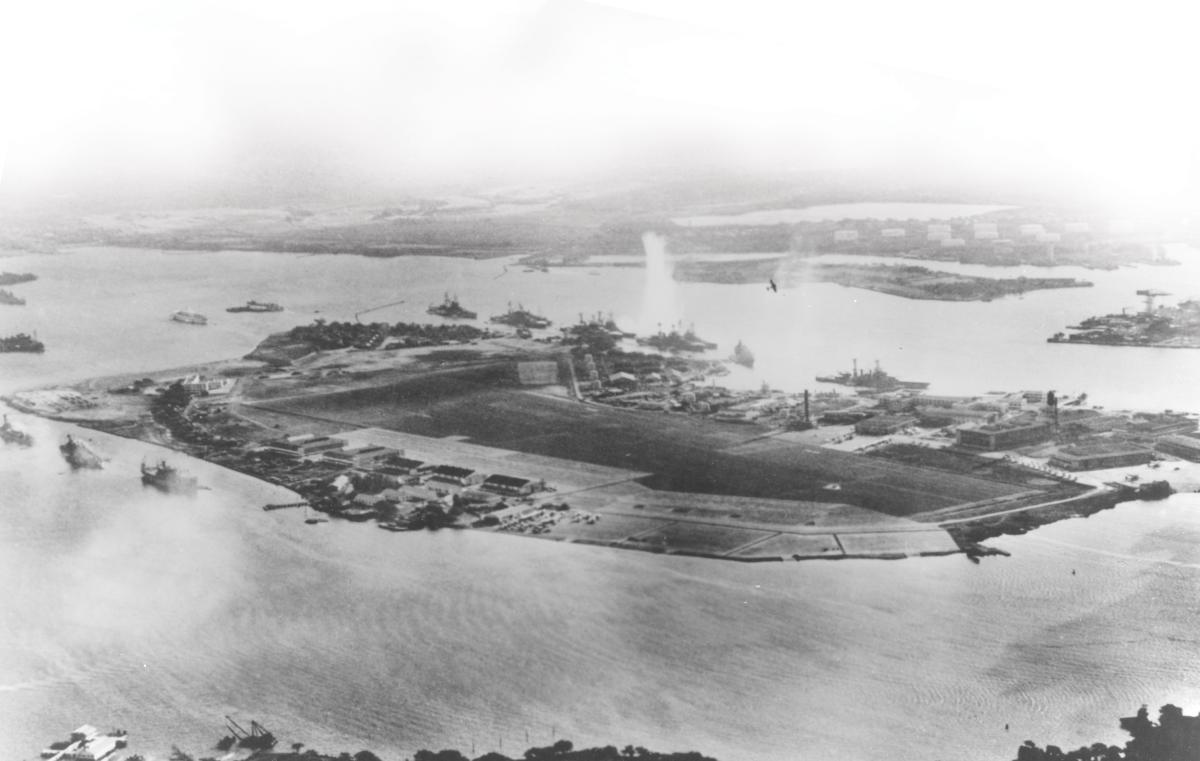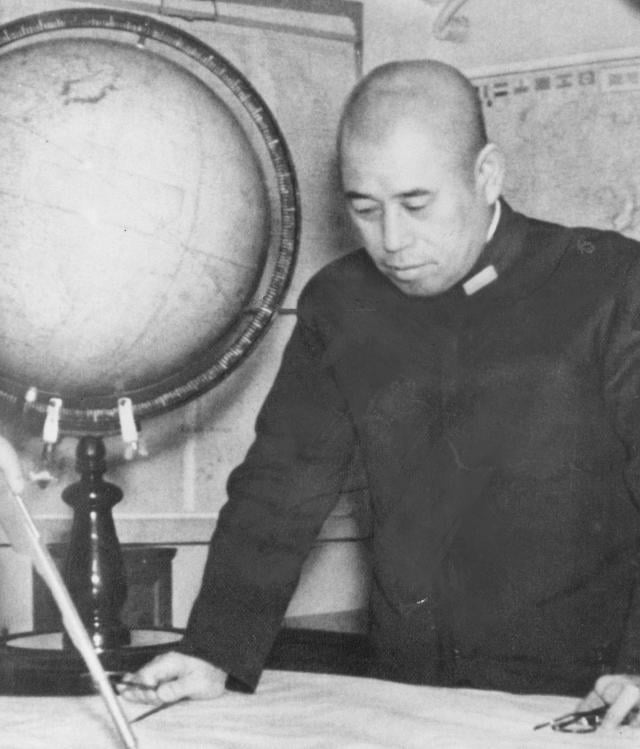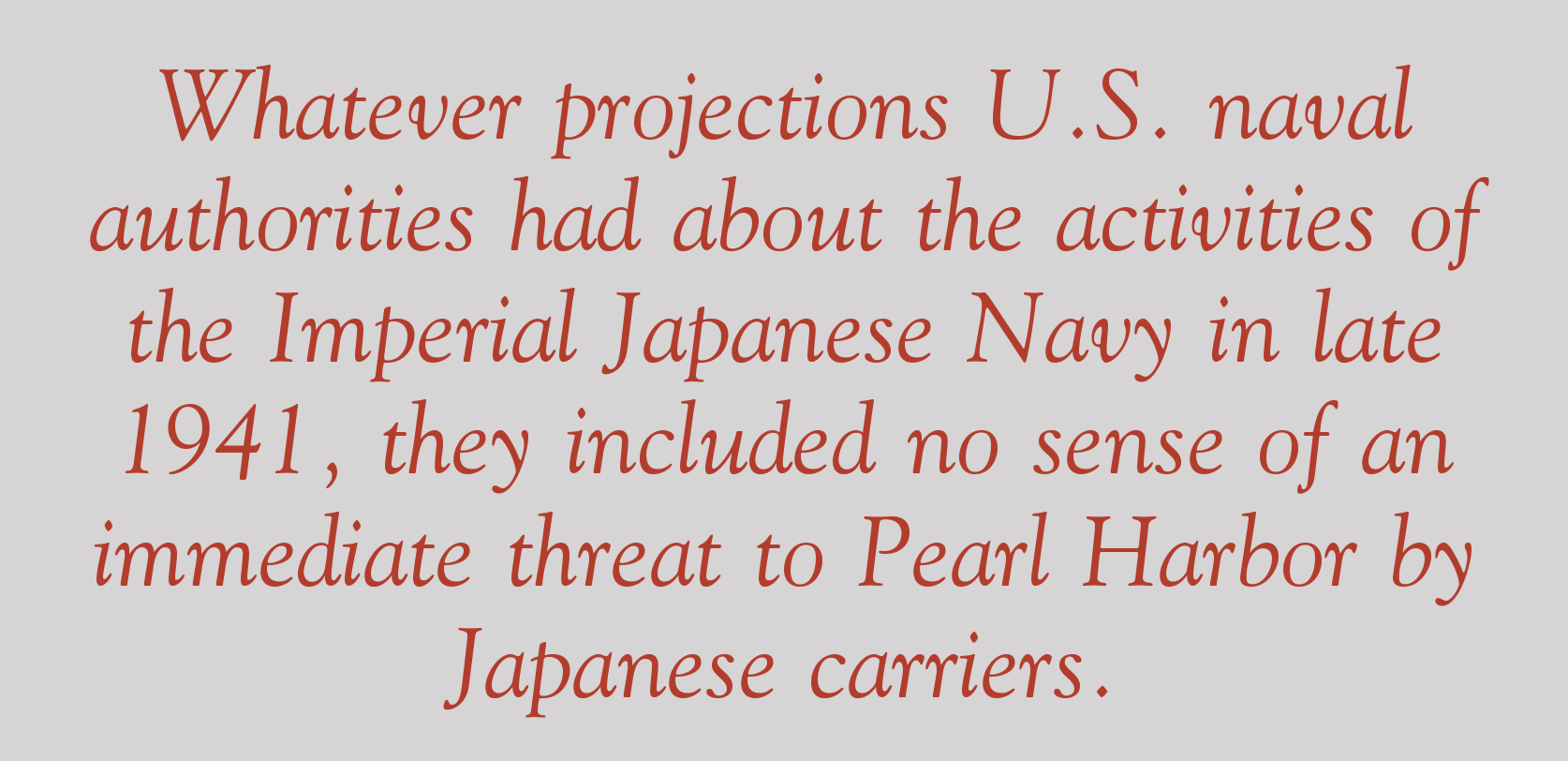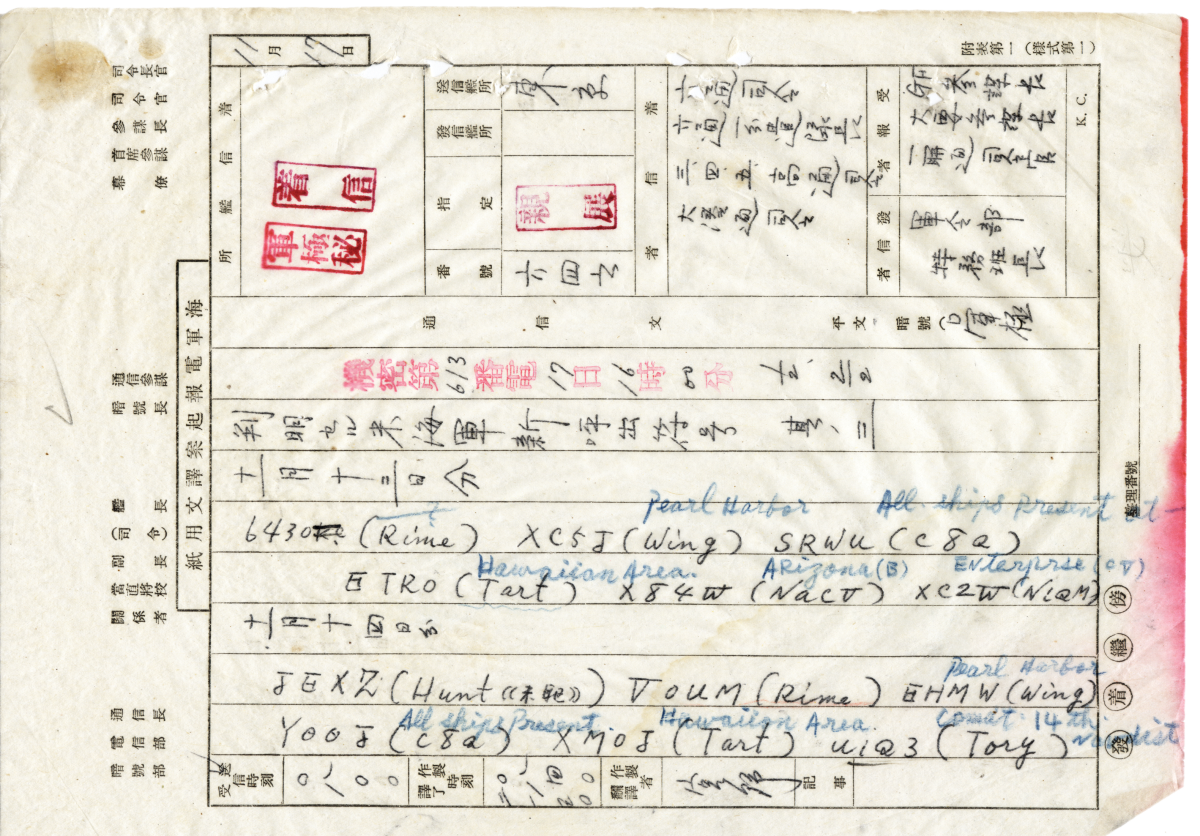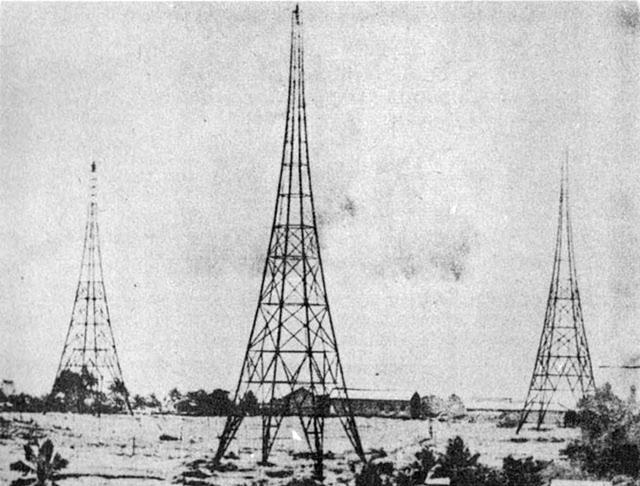Pearl Harbor. Of all the aspects of the attack on that 7 December 1941 Sunday morning-including its treachery, swiftness, daring, and skillful execution-none seems more compelling than the assault's total surprise. This element is even more striking, knowing that just prior to the attack, a U.S. Army radar site at Opana Point, on Oahu, tracked incoming aircraft, and the Navy discovered a foreign submarine at the entrance to Pearl Harbor. Add to this mixture that American code-breakers were reading Japanese diplomatic messages of all types, and it seems simply incredible that Japan could pull off a thorough surprise attack.
Yet it did precisely that. How Japan could do so has intrigued Americans ever since. Vast literature, written mostly from an American perspective, has poured out in the last six decades pursuing answers to the same questions: How did the Japanese arrive in secret, and why were the Americans caught so off guard? Not unexpectedly, these writings mostly dwell on American errors and shortcomings and usually treat Japanese planning and preparations for the strike in an abbreviated, sometimes dismissive manner. Even a standard history such as Gordon Prange's At Dawn We Slept concludes with 11 pages recounting American failures, while giving Japanese efforts three paragraphs, one of which attributes a major place to "unadulterated luck."1 Proponents of the Pearl Harbor conspiratorial thesis reduce the Japanese to mere puppets, acting unconsciously to the whims of President Franklin D. Roosevelt (and, according to a few, British Prime Minister Winston Churchill).2
While the air assault that morning was, in the words of Pacific Fleet commander Admiral Husband E. Kimmel, a "beautifully planned and executed military maneuver," it was the Japanese preparations that allowed the Pearl Harbor Task Force, the Kido Butai, to approach Hawaii undetected.3 Without the detailed planning and nearly flawless execution of the preliminaries, the attack would have never succeeded.
Comprehending Japan's prewar change in naval strategy and how the Japanese combined four major parts of the assault plan-denial and deception (D&D), radio intelligence (RI), cryptology, and operations security-is critical to understanding how the Japanese were able to pull off the attack. These components often complemented each other. One part would lead, reinforce, or extend another, and lessons learned during training and exercises sorted out which techniques worked. Simply put, how the Japanese prepared for the attack is what assured their success that morning, and it is likely the Americans could have done nothing to alter significantly the outcome of the attack.
Switching from Defense to Offense
Strategy is the script nations write for themselves that dictates subsequent policy and plans. Japan's pre-eminent interest after World War I was to expand and preserve economic hegemony in East Asia, principally China. But to fulfill that strategic aim, Japan would face opposition from colonial powers in the region and from the United States, which sought to maintain an economic "Open Door" in China and protect its island possessions. In the years prior to Pearl Harbor, Japanese-American relations were marked by confrontations over Japanese expansion into China, the seizure of Manchuria, and a buildup of naval forces and facilities in the Pacific.
Japan's naval strategy closely followed its national aims. It envisioned a two-part mission: support operations to expand to the south into Southeast Asia and the Netherlands East Indies, while protecting the Home Islands from an expected attack by the U.S. Pacific Fleet, which might threaten Japan directly or its commercial supply routes.
The effective spearheads for the Western Pacific foreign policies of both nations were their respective navies: the Pacific Fleet and the Imperial Japanese Navy (IJN). Both countries expected and trained for eventual conflict. For the Japanese, though, the naval strategy it adopted for most of the two decades prior to 1941 was essentially defensive in nature. While elements of the IJN would be engaged elsewhere to the south, the majority of the battle line-its battleships, supplemented with carriers-would remain in the home waters around the Japanese archipelago and await the expected riposte by the reinforced Pacific Fleet. Once the American ships deployed, the Japanese fleet would sortie out and seek a "decisive battle" somewhere in the mid-Pacific region.4
As ship technology advanced and Japanese carriers acquired more punch from more capable aircraft, the location of the climactic clash moved eastward until, by the late 1930s, the Japanese Naval General Staff (NGS) planned for it to occur near the Mariana Islands, some 1,400 miles southeast of Japan. Ironically, and with implications for Pearl Harbor, American plans fit neatly together with the Japanese expectations. American naval planners, in War Plan Orange and its various permutations, would send the reinforced Pacific Fleet across the Central Pacific to meet the Japanese Combined Fleet somewhere near the Marshall or Caroline Islands and destroy it before moving on to the Philippines and the eventual investment of the Japanese Home Islands.5
The Japanese strategic defense scenario remained a fixture in their fleet exercises throughout the years before World War II. American intelligence, mostly through radio intelligence and reports by naval attach?
s, was aware of this plan. As early as 1927, American radio monitors and traffic analysts had plotted the IJN annual grand maneuvers and determined that the Japanese strategic posture was largely defensive.6 This intelligence estimate, which continued into 1941, convinced the U.S. Navy's leadership that Japan's main battle force would remain in home waters and await the U.S. Pacific Fleet's move west. American naval war planning, epitomized in WPAC-46 under Admiral Kimmel, counted on this inaction and called for an advance across the Central Pacific once hostilities began.7
In January 1941, however, Admiral Isoroku Yamamoto proposed the idea of a sneak attack on Pearl Harbor. In essence, he overturned more than two decades of Japanese naval strategic thinking. The Japanese NGS opposed this idea for nearly nine months before yielding to Yamamoto. Planning, training, and war games in September 1941 revealed technical and operational shortcomings that needed to be fixed if his plan was to work. Significantly, U.S. naval intelligence did not detect the shift in thinking. American radio intelligence continued to analyze Japanese naval activity in 1941 within the context of the old defensive strategy. U.S. analysts assumed the carriers and most of the battle line would remain in Japanese home waters. All Yamamoto needed was some way to convince the Americans to continue to think that way.
Covering Up the Strategic Change
The key to the success of the Japanese attack on Pearl Harbor-specifically, what enabled the Pearl Harbor Striking Force to reach its launch point undetected (and totally unsuspected) by the Americans-was Tokyo's radio denial-and-deception actions. Significantly, these activities simply were not just a "bag of tricks" meant to bemuse U.S. naval radio intelligence. Rather, they constituted a function of the change in Japanese strategy and were meant to convince the Americans that there had been no change from defensive to offensive intentions.
Two observations about Japanese D&D further explain its success. First, the impetus for the IJN's elaborate radio ruse was its awareness of the ability of enemy radio intelligence to identify and locate Japanese carriers. Earlier, in March and June 1941, when carriers had been dispatched south to support Tokyo's policy toward occupied French Indochina, Japanese radio intelligence discovered that the British monitoring site in Hong Kong had identified and tracked the large ships. (It is not known if the Japanese realized that American naval radio intelligence had done so as well.) Alerted to the vulnerability of its communications to foreign RI, the Japanese naval command was compelled to devise a counterplan.8
Second, the radio D&D program began in mid-November 1941 on the heels of a weeklong communications drill-a series of scheduled radio contacts between selected ships and stations.9 The deception was intended to appear to American radio monitors in the Philippines and Hawaii as a continuation of the same communications exercise. The drill had begun as the ships of the Kido Butai moved to a rendezvous point in the Inland Sea of Japan. The deception phase kicked in as the ships of the task force "buttoned up" on their way to the Kuriles on 17 November.
Beginning in mid-November, the American stations in Hawaii and the Philippines intercepted about a dozen transmissions-no messages, just calls and radio "chatter"-seemingly from the IJN carriers. This paucity of monitored emissions worked to Japan's advantage since it reinforced an American perception that Tokyo's carriers were in home waters and largely inactive, which was reported in Communications Intelligence Unit summaries to Admiral Kimmel as "nothing on the carriers" or "no information." Kimmel would report to various hearings that these periods of silence or inactivity were nothing new; at least eight times in the previous six months it was uncertain where the ships were because of few or no transmissions.10
As the carriers' apparent transmissions were picked up by the U.S. Navy monitoring station at Corregidor, the Philippines, direction-finding (DF) gear was used to plot lines of bearing on the their call signs.11 The resulting lines crossed over the Japanese naval bases of Sasebo, Kure, or Yokosuka, which suggested the carriers were at these bases. For American naval intelligence analysts in Washington, Hawaii, and the Philippines, the congruence of the lines verified the conclusion that the carriers were still in home waters as expected, refitting, training, or preparing for the expected emergence of the Pacific Fleet from Pearl Harbor.12 More important, these lines of bearing also coincided with results obtained on the carriers' transmissions from August through November 1941, as the IJN operated in the waters around the southern Home Island of Kyushu.13
Whatever projections U.S. naval authorities had about the activities of the IJN in late 1941, they included no sense of an immediate threat to Pearl Harbor by Japanese carriers. Their own radio intelligence confirmed this.
Monitoring American Radio Traffic
The role of Japanese radio intelligence, primarily by the IJN, but also the small part played by Japan's Post, Telegraph, and Telephone (PT&T) Ministry, has remained largely unknown to Americans. Most narratives mention a small team on board the Kido Butai's flagship, the carrier Akagi, which listened to Hawaiian commercial stations for any alert. But that is a mere fraction of the story.
Briefly, radio intelligence is information that can be gleaned from communications excluding cryptanalysis. RI is derived from the "externals" of messages and the transmission of such traffic, such as message priority, call signs, and radio direction finding. In a useful analogy, radio intelligence is like studying the envelope and delivery method of a letter. We can learn who sent it, the date, relative size, and the delivery system. But any conclusion based on RI is largely inferential and can be misleading without corroborative intelligence.
For years before the Japanese Navy began to grapple with Yamamoto's idea for a surprise attack on Pearl Harbor, the IJN's radio intelligence section had monitored U.S. Pacific Fleet exercises and activities. While the Japanese intercepted and studied the communications of other fleets in the Pacific, such as the Royal Navy and Soviet Pacific Squadron, the Pacific Fleet was its priority target. Like most major navies, Japan had established an RI capability early in the 1920s. Radio intelligence was handled in the "Special Section" of the Communications Department of the Navy General Staff, which used listening posts on various Japanese-held islands. Tokyo also dispatched merchant ships with special monitoring teams on board to track annual U.S. fleet exercises.14
In late May 1940, President Roosevelt ordered the Pacific Fleet to remain in Pearl Harbor after the completion of Fleet Problem XXI. (The fleet had been based in San Diego, California, with Pearl Harbor serving as an advanced deployment base.) Roosevelt hoped it would act as some sort of deterrent.15 An unexpected result of the move, however, was that the Pacific Fleet's communications were now within range of the Japanese RI station on Kwajalein. Listening in on Pearl Harbor, this unit, the First Detachment of the Sixth Communications Unit, was able to gather much more intelligence than before the transfer. Additional information came from Japan's PT&T Ministry, which monitored commercial telegrams and radio telephone calls by Pacific Fleet Sailors to their families on the mainland. Sailing schedules, supply-train arrivals, unit manning, and ship locations were available in open communications.16 The Japanese also copied Pacific Fleet headquarters communications with Navy outposts on Midway, Guam, Samoa, and Johnston Island.
Into the summer of 1941, as plans for the attack on Pearl Harbor advanced, the IJN beefed up its radio-intelligence coverage of the American military presence in Hawaii. Two more stations, on Saipan and near Tokyo, now covered the communications of the Pacific Fleet and the U.S. Army Air Corps in Hawaii. A new RI command structure in Tokyo organized the effort with a greater emphasis on ship identification and direction finding. Daily reports from Kwajalein, which included listings of U.S. Navy call signs for its ships and shore stations, were passed to Tokyo. Call signs for ships such as the USS Arizona (BB-39), Enterprise (CV-6), and Astoria (CA-34) were noted.17 The Kwajalein DF station tracked the routes of American aircraft flying among the U.S. Pacific bases, but more important, it tracked reconnaissance flights around the Hawaiian Islands. The results revealed that the flights were almost exclusively to the west and south of the island chain. The north, the direction from which the Kido Butai would approach, remained uncovered.
Radio intelligence supplemented reports from Japanese agent Takeo Yoshikawa, who operated out of the consulate in Honolulu. His information was the primary intelligence source for the IJN on Pearl Harbor, but his tenure was precarious. At any time he could be compromised and shut down. Also, his reports were limited. He provided little information on U.S. air activity around Hawaii, his intelligence could take up to two days to reach the Kido Butai, and he had no way of monitoring radio communications. When the attack came, his role would end. Japanese RI, however, could compensate for all the shortcomings.
The U.S. Pacific command did not miss the spike in Japanese DF activity. A daily Traffic Intelligence Summary presented to Admiral Kimmel noted that since October Japanese DF nets were extremely active. The 28 November edition carried an assessment by Commander Edward Layton, Kimmel's fleet intelligence officer, that the Japanese DF was "getting results."18 Because U.S. naval intelligence could not read the DF messages encrypted in a special cipher, Layton could not have known that they contained information on the critical holes in the American aerial reconnaissance around Hawaii.
One further aspect of Japanese RI against Hawaii occurred in late 1940 as the U.S. Army Signal Corps was testing a new speech-scrambler system for radio telephone calls between Honolulu and San Francisco. Designed by AT&T, this A-3 device was already in use between Washington and U.S. embassies in Europe. When the scrambler was turned on for the test, an operator in Japan broke in and asked if something was wrong with the channel, because Tokyo could not understand the voice transmission between the two American terminals. This indicated that the Japanese PT&T Ministry was monitoring calls between Honolulu and the United States.19
As the Japanese strike force approached the Hawaiian Islands, it was receiving current radio intelligence via a Tokyo naval broadcast (which it did not need to acknowledge by radio), from monitoring and DF units at three land sites, as well as from an RI team on board the Akagi, which listened not just to commercial broadcasts from Honolulu but naval and air communications as well. Additionally, numerous Japanese Sixth Fleet submarines dispatched earlier to scout the area and attack U.S. ships carried small radio-intercept teams, whose mission was to provide intelligence to the submarines.20
The Japanese RI effort would keep the Kido Butai informed of any changes to the status of U.S. forces in Hawaii and warn the task force if its presence was known.
Breaking the Japanese Codes
Japanese cryptology, like its radio-intelligence program, began in earnest after World War I. The IJN opted for codebooks and charts. It further encrypted messages by using auxiliary systems such as transposition ciphers, which scrambled the code groups according to a key. Thanks to a combination of good cryptanalysis and the purloining of copies of these early codes, American code-breakers from the Navy's OP-20-G broke and exploited the encrypted messages for about 15 years.
In mid-1939, the IJN brought in a new general purpose operational code, designated AN by the Americans. Its codebook contained more than 35,000 five-digit code groups and a digital cipher to encrypt them. American naval code-breakers had made limited progress on this system when the Japanese replaced it in December 1940 with a new code, designated AN-1, with more than 50,000 code groups.
The mistaken claim that the AN-1 code was being "read" or exploited at the time of Pearl Harbor is based on out-of-context quotes and numerous technical misunderstandings of the U.S. code-breaking process. A review of the monthly progress statements of the U.S. Navy's code-breaking section, OP-20-GYP-1, shows minimal recovery of the code-only about 8 percent of the 50,000 code groups had been recovered. The U.S. Navy could not glean intelligence from messages encrypted with AN-1 until early 1942, and even then, the results were fragmentary at best.21 No intelligence about Pearl Harbor could come from this source.
The Americans, however, could exploit encrypted Japanese diplomatic messages to a great degree, though not quite as much as imagined by later historians. From late 1939 to mid-1940, Japan introduced new diplomatic ciphers to protect their communications. These included the iconic Purple cipher device and several manual systems, including the J-19 enciphered code. Within 1.5 years, these systems had largely succumbed to American Army and Navy code-breaking elements. Still, the rates for exploitation of these messages were not that high. From 1 November to 7 December 1941, 59 percent of all Purple messages between Tokyo and Washington and 16 percent of J-19 were translated.22
Japan's own code-breaking effort was another story. While Japanese naval cryptanalysts could make no headway into the primary U.S. naval systems, Tokyo could read American diplomatic systems, including old codes such as the Brown and Grey series. Unknown to the Americans, however, Tokyo also could read the high-level system M-138 strip cipher. Considered secure by the Americans, the system had been compromised in 1940, and the Japanese Foreign Ministry was able to read many significant American diplomatic dispatches prior to hostilities.23 It is still unclear what advantage the Japanese gained from this ability.
Keeping the Secret
Operations Security (OPSEC) consists of all measures taken to ensure that intelligence about operations, activities, etc., is denied to an enemy. Although defensive in nature, certain OPSEC techniques, such as quarantine, can be proactive.
For the Japanese, securing the secret of the Pearl Harbor operation meant instituting security measures to restrict access to knowledge of the attack to only those who had "the need to know" as well as to keep anyone-foreign or domestic-away from Kido Butai training areas, facilities, or personnel.
From the beginning of the planning for the Hawaii operation in early January 1941 until the summer of that year, the IJN kept information about the plan limited to small groups of officers within the operations and command staffs of the Combined Fleet, the Naval General Staff, and the First Air Fleet. By August and September, as preparations intensified, more people within the IJN learned of the plan. Army and civilian leaders were alerted to the plan late in 1941. It is possible that the senior Army leadership learned of the plan by August and cabinet officers in early November, but details were only forthcoming in late November.24 The Japanese diplomats in Washington and Honolulu were not informed of the attack, which was the best way to ensure they sincerely relayed Tokyo's insincere negotiating points.
Within the IJN, the 700 printed copies of Yamamoto's Combined Fleet Top Secret Operations Order No. 1 of 5 November 1941 to the IJN did not carry the annex for the Hawaiian operations. The majority of senior officers of the Kido Butai were not officially notified of the plan until 17 November, when Yamamoto held his last conference with the task force commanders. The rest of the crews were not told of the attack until the ships reached the anchorage at Tankan Bay in the Kuriles on 23 November. There, all mail and communications between the sailors and Japan were curtailed.25
Interestingly, Japanese OPSEC around the plan extended to their enciphered diplomatic and naval messages. Tokyo's diplomatic traffic included references to activity in Southeast Asia and a probable starting date for the campaign, 8 December (Tokyo time) as "X-day," but these only tipped off Japanese movements toward Southeast Asia. Yoshikawa's reports from Honolulu were no different than those from other sites such as Manila and the Panama Canal-detailed intelligence but no mention of an attack. Encrypted operational, weather, and training messages meant for the Kido Butai never openly mentioned Pearl Harbor; the plan and target could only be inferred from the postwar decrypts.
Japanese restrictions against prying attaches and diplomats proved effective. Areas around Kyushu as well as the southern island's navy yard and training areas had been closed off to foreign observation. By 17 November, the American ambassador to Tokyo, Joseph Grew, informed Washington that security was so tight in Japan that the embassy could no longer be counted on to provide an effective war warning.26 Japanese newspaper stories about the navy had been censored. Foreign ships approaching training areas near Kyushu had been stopped. Potential adversaries' ships were escorted out of the area, while one, a Filipino freighter, was boarded, its radio sealed and seized, and the ship sailed to Naha, Okinawa.27
This OPSEC blanket over the operations was not perfect. In at least one case in September, aircraft from the Hiryu spotted a small foreign combatant near one of the Kido Butai training areas. Still, overall, knowledge of the attack was held closely within Japan and away from foreigners.
And on the Morning of the Attack . . .
On 7 December, naval and military commands in Hawaii did not suspect an attack would happen, though in previous years, studies and exercises had imagined such an event. In Washington, the same frame of mind existed among the political, naval, and military leadership. Washington and Honolulu were aware of the Japanese threat to attack areas in Southeast Asia. Reports had come in of Japanese troopships and escorts moving south toward Malaya and of aerial reconnaissance over the Philippines, developments indicating plans in that region. But Pearl Harbor? A surprise attack was not part of the calculations in Honolulu or Washington.
This unpreparedness had nothing to do with an imaginary conspiracy high within the U.S. government. The reason was that the commands in Washington and Honolulu acted according to the intelligence they had received, almost exclusively, from U.S. radio intelligence and diplomatic code-breaking. The intelligence told them the Japanese were moving south and hostilities were likely to begin soon, but Pearl Harbor was not in danger. The best available intelligence on the only real threat to the Pacific Fleet, the Japanese carriers, indicated they were in home waters. This is what Admiral Kimmel reported to the Roberts Commission soon after the attack. So certain was he that there was no threat, he had held back patrol planes to have them ready for the expected order to execute an offensive plan, WPAC-46.28
In Washington just a few hours before the attack, the Office of Naval Intelligence handed its estimate of Japanese naval forces to the secretaries of State, War, and the Navy. It placed all of the IJN's fleet carriers at home. The Japanese radio deception had spread like a virus, infecting the intelligence assessments in Hawaii and Washington.29 Japan had successfully hid its polar change in strategy and now had the Combined Fleet, including its attack carriers, ready to hurl its aircraft at Hawaii. Japanese radio intelligence listened in on an unsuspecting Pacific command, while Tokyo's cryptology and OPSEC kept foreign intelligence at arm's length. In a telling detail, that morning Army Chief of Staff General George C. Marshall decided not to phone Honolulu with news the Japanese would that day present "what amounts to an ultimatum." Likely recalling the incident of the Japanese listening in on the A-3 scrambler tests, he instead chose to send the information in a telegram.30
All of this is not to say the Japanese did not make mistakes or tempt chance. They did. The part of the attack plan that called for midget submarines to infiltrate Pearl Harbor nearly ruined the surprise. The carrier task force sailed east "blind." Submarines meant to scout ahead were pulled back because of high seas, and the Kido Butai's air chief, Commander Genda Minoru, decided against air reconnaissance because the planes could get lost, ask for a navigational beacon, and possibly compromise the force's location.31
Still, the Americans never pierced the shroud the Japanese Navy draped over the Pearl Harbor attack. Due to the sparse information, intelligence officers like Edwin Layton may have occasionally been uncertain of the carriers' location, but at no time did he or others have any indication of the approaching Kido Butai. The Japanese completely fooled U.S. intelligence.
The implication of that is a far more sobering conclusion than any imagined conspiracy, for it revealed that a knowledgeable and technically adept opponent could effectively negate apparent advantages held by the American intelligence community. So effective was the Japanese denial-and-deception campaign that, when asked during a Pearl Harbor investigation when he finally again heard from the carriers, the chief of the Communications Intelligence Unit in Hawaii, Commander Joseph Rochefort, could only reply, "The 7th of December."32
1. Gordon W. Prange, At Dawn We Slept: The Untold Story of Pearl Harbor (New York: McGraw-Hill, 1981), pp. 725–737.
2. Principally, Robert B. Stinnett, Day of Deceit: The Truth about FDR and Pearl Harbor (New York: Free Press, 1999) and James Rusbridger and Eric Nave, Betrayed at Pearl Harbor: How Churchill Lured Roosevelt into World War II (New York: Summit Books, 1991).
3. U.S. Congress, Hearings before the Joint Committee on the Investigation of the Pearl Harbor Attack, 79th Congress. (Washington, D.C.: U.S. Government Printing Office, 1946) (cited hereinafter as PHH), Part 22: p. 388.
4. David C. Evans and Mark R. Peattie, Kaigun: Strategy, Tactics, and Technology in the Imperial Japanese Navy, 1887–1941 (Annapolis: Naval Institute Press, 1997), pp. 285-291.
5. American naval planning was sometimes more aggressive in its timetable, but its objectives remained constant. See Edward S. Miller, War Plan Orange: The U.S. Strategy to Defeat Japan, 1897–1945 (Annapolis: Naval Institute Press, 1991), pp. 286-315.
6. For example, see Various Reports on Japanese Grand Fleet Maneuvers (July-September 1935), SRH-225. (Fort Meade, MD: National Security Agency, 1983).
7. PHH, Part 22: p. 328; Miller, pp. 282–285, 294–5, 317–8.
8. Ishiguro Interview No. 8, 1 May 1948. University of MD, Prange Collection, Box 19, Folder: "Ishiguro Aboard Soryu."
9. Japanese Naval Translation (SRN) 116602. National Archives and Records Administration, College Park, MD (cited hereinafter as NARA), RG 457, Entry 9014.
10. PHH Part 24: pp. 1,385-6; Robert J. Hanyok, "Catching the Fox Unaware. Japanese Radio Denial and Deception and the Attack on Pearl Harbor," Naval War College Review (Vol. 61, No. 4, Autumn 2008) pp. 99-124.
11. The USN monitoring station in the Philippines, along with the analytic section, often referred to as CAST, had moved from Cavite to Corregidor in October 1940.
12. Hanyok, pp. 100–102.
13. "Translations of Intercepted Enemy Radio Traffic and Miscellaneous World War II Documentation," NARA, RG 38, Entry 344, Box 1356, "Akagai."
14. A good example of Japanese merchant ship as a radio monitoring platform, the tanker Ondo Maru, which monitored the Pacific Fleet Fleet Problem of 1937. See "JN Tanker Activity against USN Maneuvers (1937)," NARA, RG 38, Inactive Stations, Box 18, Folder 3222/12.
15. Prange, pp. 37-39.
16. Yokoi Tishiyuji, Rear Admiral, The Black Chamber of the Imperial Japanese Navy (July 1953), pp.15–16.
17. "Japanese Analysis of U.S. Navy Message Headings," November 1941, RG 457, Entry 9032, Box 151, Folder 646.
18. SRMN-012, "Combat Intelligence Unit, 14th Naval District Traffic Intelligence Summaries with Comments by CINCPAC, War Plans, Fleet Intelligence Sections, 16 July 1941-30 June 1942" (Fort George G. Meade, MD: NSA/CSS, 6 September 1985), pp. 205-230.
19. PHH, Part 22: pp. 243–245.
20. PHH, Part 13: p. 414; "Translations of Intercepted Enemy Radio Traffic and Miscellaneous World War II Documents," NARA, RG 38, Entry 344, Box 221.
21. NARA, RG 38, Entry 1040, Box 116, Folder 5750/202, "History of GYP-1; RG 38, CNSG Library, Box 22, Folder 3222/82 for first translation from JN-25B (then AN-1) completed on 8 January 1942.
22. PHH, Part 37: pp. 1081-3; "Worksheets for Japanese Diplomatic Traffic, 1941," RG 38, Entry 1030, Box 165, Folder 5830/62, "Pearl Harbor Investigations."
23. "Survey of Cryptographic Security at the Department of State," RG 457, Entry 9032, Box 1384, Folder 4400; Cryptanalytic Section of the Japanese Foreign Office," DF-169, CSGAS-14, July 1949; NSA Memorandum, FM D33, 3 January 1968, "State Department Messages," NSA MDR 52717. The existing set of Japanese decrypts can be found in the Diplomatic records Office, Tokyo, "U.S.-Japan Relations, Miscellaneous Diplomatic Correspondence-Special Information File." (A-1-3-1, 1-3-2).
24. Robert Butow, Tojo and the Coming of the War (Palo Alto: Stanford University Press, 1961), p. 375; Donald M. Goldstein and Katherine V. Dillon, The Pearl Harbor Papers (Dulles, VA: Brassey's, 2000), p. 142.
25. NARA, RG 457, Entry 9014, SRN 115678 and 117814.
26. PHH, Part 14: pp.1058-60, "Tokyo to Washington," 17 November 1941, Serial 711.94/2447.
27. NARA, RG 457, Entry 9014, SRN 116763 and SRN 117693.
28. PHH Part 23: p.1133.
29. "Locations of U.S. Naval Force in the Atlantic, Pacific and Far East; Also Foreign Naval Forces in the Pacific and Far East: as of 7 December 1941," PHH, Part 20, pp. 4121-31.
30. PHH. Part 3: pp. 1211-1214; Michael Gannon, Pearl Harbor Betrayed (New York: John Macrae, 2001), pp. 233–4.
31. Prange, p. 227.
32. PHH, Part 23: p. 680.



